CRITICAL APPRAISAL OF A RESEARCH PAPER: Factors Influencing Nursing Adherence to Work
VerifiedAdded on 2023/04/25
|12
|3310
|54
AI Summary
This critical appraisal focuses on the ethnographic research conducted by Ahlstedt et al. (2019) which aims to assess the various influencing factors which motivate a nurse to adhere to their existing occupational conditions.
Contribute Materials
Your contribution can guide someone’s learning journey. Share your
documents today.
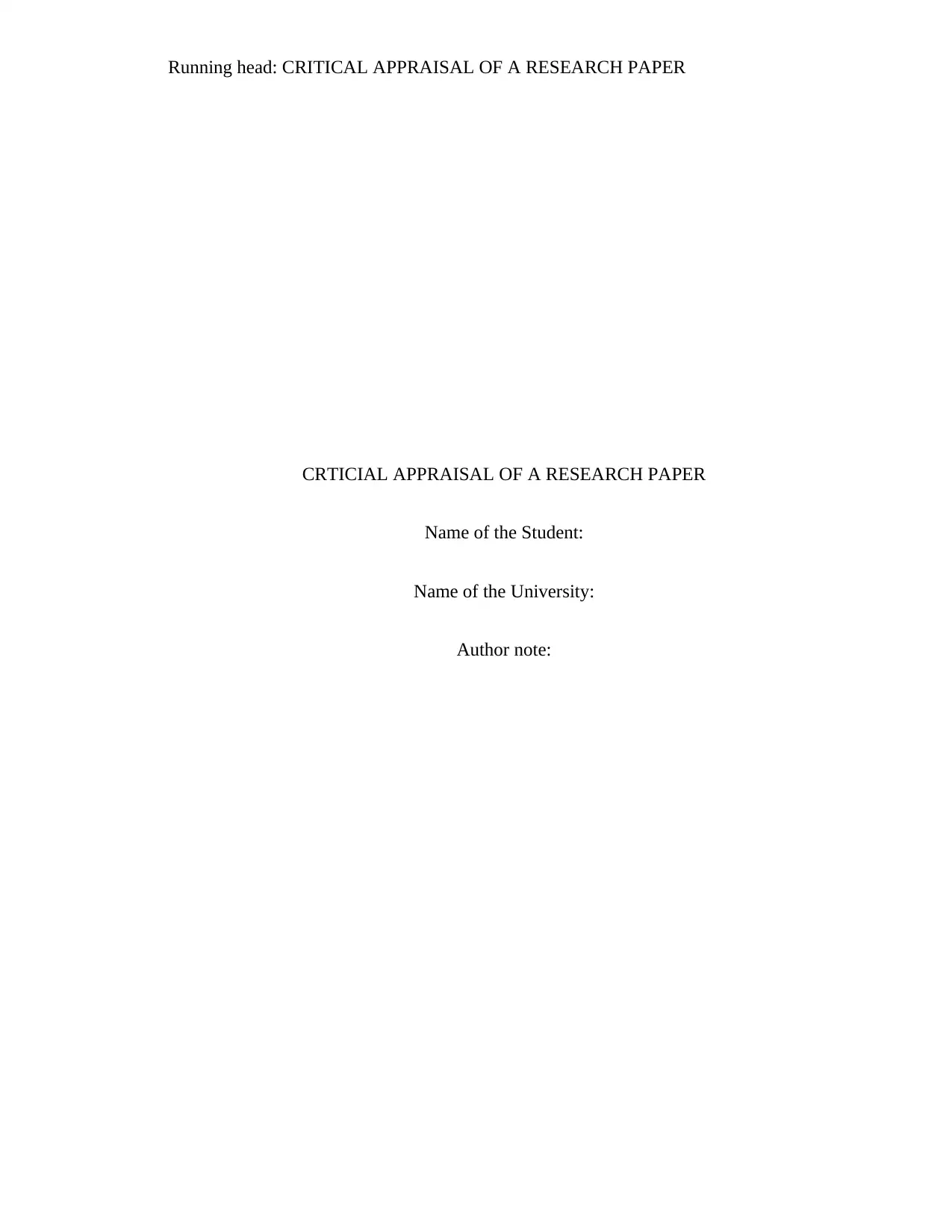
Running head: CRITICAL APPRAISAL OF A RESEARCH PAPER
CRTICIAL APPRAISAL OF A RESEARCH PAPER
Name of the Student:
Name of the University:
Author note:
CRTICIAL APPRAISAL OF A RESEARCH PAPER
Name of the Student:
Name of the University:
Author note:
Secure Best Marks with AI Grader
Need help grading? Try our AI Grader for instant feedback on your assignments.
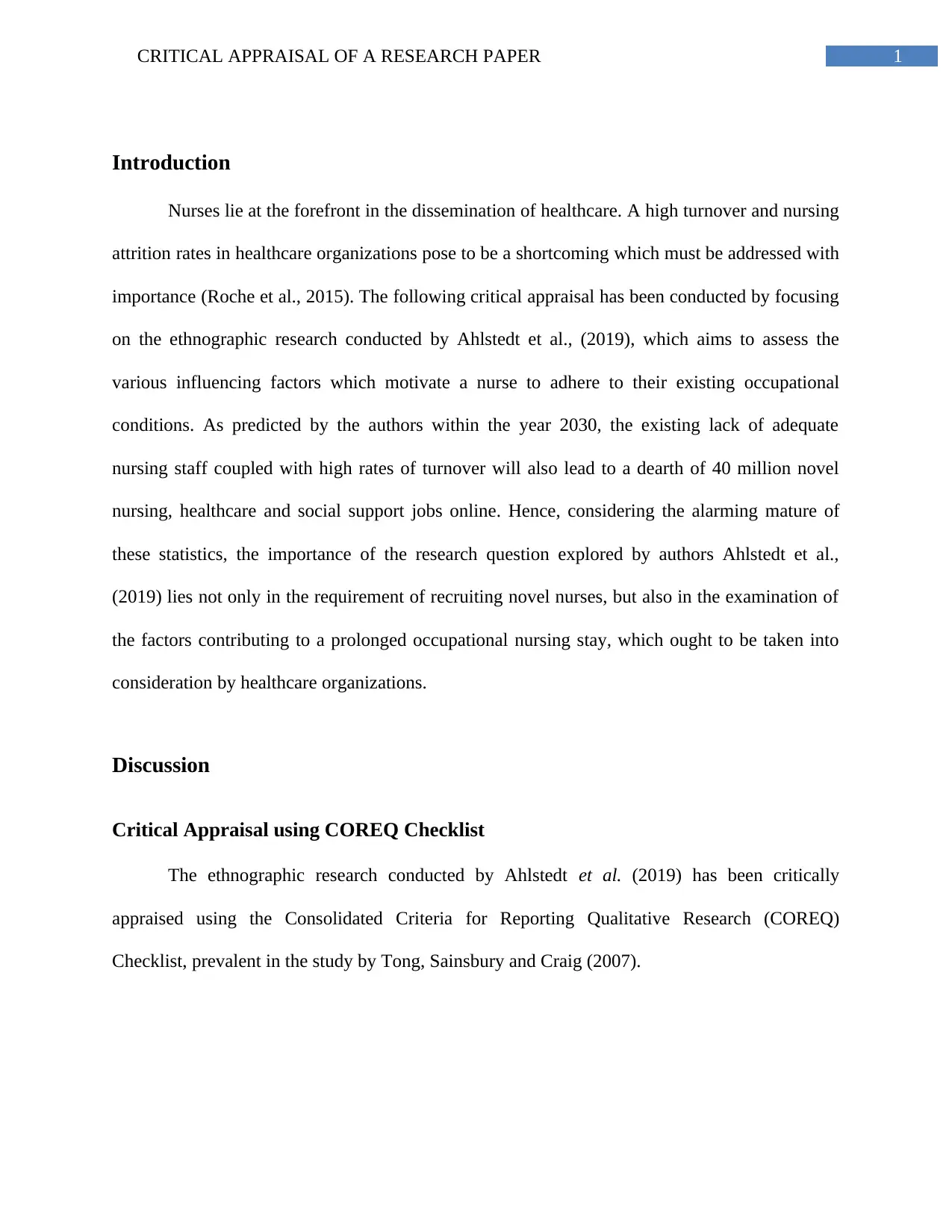
1CRITICAL APPRAISAL OF A RESEARCH PAPER
Introduction
Nurses lie at the forefront in the dissemination of healthcare. A high turnover and nursing
attrition rates in healthcare organizations pose to be a shortcoming which must be addressed with
importance (Roche et al., 2015). The following critical appraisal has been conducted by focusing
on the ethnographic research conducted by Ahlstedt et al., (2019), which aims to assess the
various influencing factors which motivate a nurse to adhere to their existing occupational
conditions. As predicted by the authors within the year 2030, the existing lack of adequate
nursing staff coupled with high rates of turnover will also lead to a dearth of 40 million novel
nursing, healthcare and social support jobs online. Hence, considering the alarming mature of
these statistics, the importance of the research question explored by authors Ahlstedt et al.,
(2019) lies not only in the requirement of recruiting novel nurses, but also in the examination of
the factors contributing to a prolonged occupational nursing stay, which ought to be taken into
consideration by healthcare organizations.
Discussion
Critical Appraisal using COREQ Checklist
The ethnographic research conducted by Ahlstedt et al. (2019) has been critically
appraised using the Consolidated Criteria for Reporting Qualitative Research (COREQ)
Checklist, prevalent in the study by Tong, Sainsbury and Craig (2007).
Introduction
Nurses lie at the forefront in the dissemination of healthcare. A high turnover and nursing
attrition rates in healthcare organizations pose to be a shortcoming which must be addressed with
importance (Roche et al., 2015). The following critical appraisal has been conducted by focusing
on the ethnographic research conducted by Ahlstedt et al., (2019), which aims to assess the
various influencing factors which motivate a nurse to adhere to their existing occupational
conditions. As predicted by the authors within the year 2030, the existing lack of adequate
nursing staff coupled with high rates of turnover will also lead to a dearth of 40 million novel
nursing, healthcare and social support jobs online. Hence, considering the alarming mature of
these statistics, the importance of the research question explored by authors Ahlstedt et al.,
(2019) lies not only in the requirement of recruiting novel nurses, but also in the examination of
the factors contributing to a prolonged occupational nursing stay, which ought to be taken into
consideration by healthcare organizations.
Discussion
Critical Appraisal using COREQ Checklist
The ethnographic research conducted by Ahlstedt et al. (2019) has been critically
appraised using the Consolidated Criteria for Reporting Qualitative Research (COREQ)
Checklist, prevalent in the study by Tong, Sainsbury and Craig (2007).
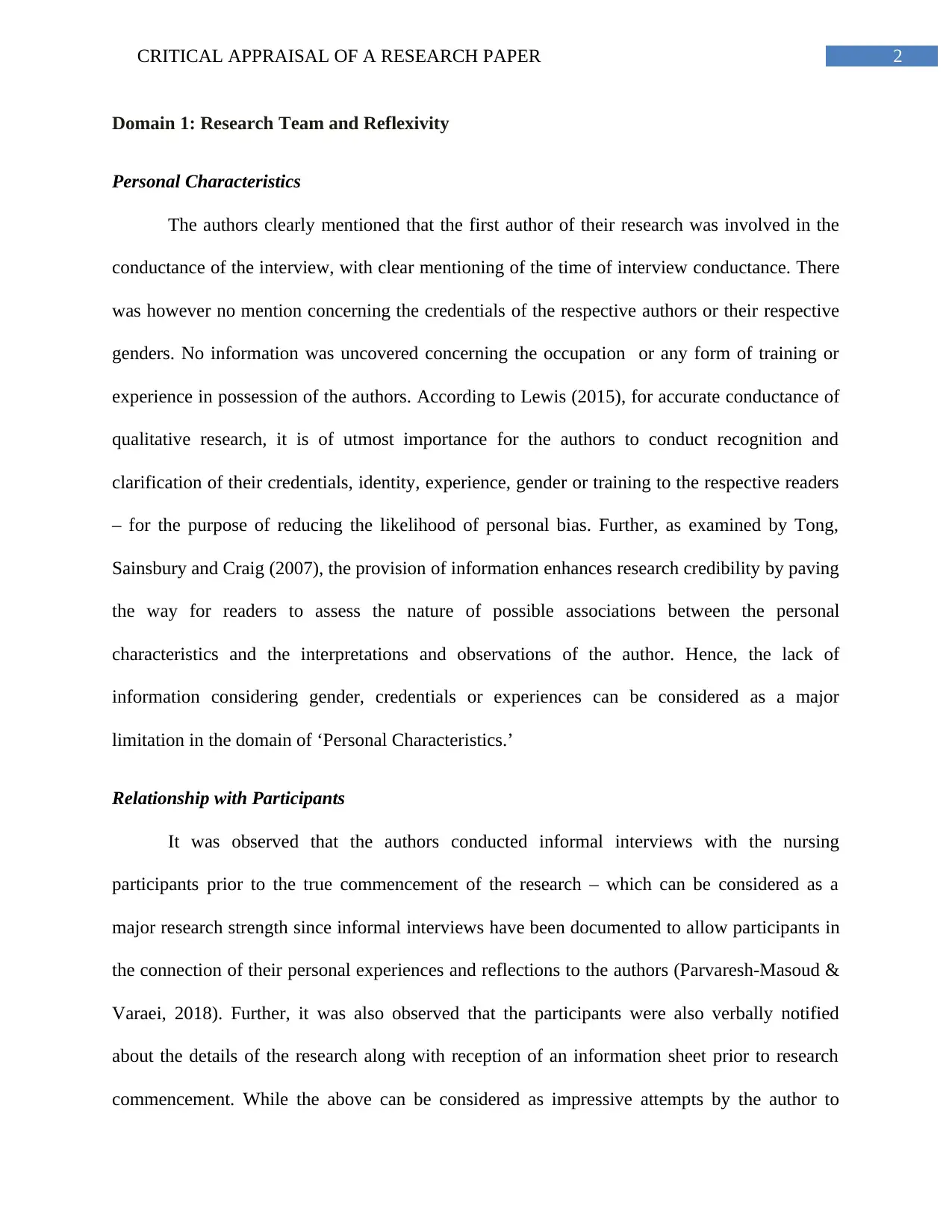
2CRITICAL APPRAISAL OF A RESEARCH PAPER
Domain 1: Research Team and Reflexivity
Personal Characteristics
The authors clearly mentioned that the first author of their research was involved in the
conductance of the interview, with clear mentioning of the time of interview conductance. There
was however no mention concerning the credentials of the respective authors or their respective
genders. No information was uncovered concerning the occupation or any form of training or
experience in possession of the authors. According to Lewis (2015), for accurate conductance of
qualitative research, it is of utmost importance for the authors to conduct recognition and
clarification of their credentials, identity, experience, gender or training to the respective readers
– for the purpose of reducing the likelihood of personal bias. Further, as examined by Tong,
Sainsbury and Craig (2007), the provision of information enhances research credibility by paving
the way for readers to assess the nature of possible associations between the personal
characteristics and the interpretations and observations of the author. Hence, the lack of
information considering gender, credentials or experiences can be considered as a major
limitation in the domain of ‘Personal Characteristics.’
Relationship with Participants
It was observed that the authors conducted informal interviews with the nursing
participants prior to the true commencement of the research – which can be considered as a
major research strength since informal interviews have been documented to allow participants in
the connection of their personal experiences and reflections to the authors (Parvaresh-Masoud &
Varaei, 2018). Further, it was also observed that the participants were also verbally notified
about the details of the research along with reception of an information sheet prior to research
commencement. While the above can be considered as impressive attempts by the author to
Domain 1: Research Team and Reflexivity
Personal Characteristics
The authors clearly mentioned that the first author of their research was involved in the
conductance of the interview, with clear mentioning of the time of interview conductance. There
was however no mention concerning the credentials of the respective authors or their respective
genders. No information was uncovered concerning the occupation or any form of training or
experience in possession of the authors. According to Lewis (2015), for accurate conductance of
qualitative research, it is of utmost importance for the authors to conduct recognition and
clarification of their credentials, identity, experience, gender or training to the respective readers
– for the purpose of reducing the likelihood of personal bias. Further, as examined by Tong,
Sainsbury and Craig (2007), the provision of information enhances research credibility by paving
the way for readers to assess the nature of possible associations between the personal
characteristics and the interpretations and observations of the author. Hence, the lack of
information considering gender, credentials or experiences can be considered as a major
limitation in the domain of ‘Personal Characteristics.’
Relationship with Participants
It was observed that the authors conducted informal interviews with the nursing
participants prior to the true commencement of the research – which can be considered as a
major research strength since informal interviews have been documented to allow participants in
the connection of their personal experiences and reflections to the authors (Parvaresh-Masoud &
Varaei, 2018). Further, it was also observed that the participants were also verbally notified
about the details of the research along with reception of an information sheet prior to research
commencement. While the above can be considered as impressive attempts by the author to
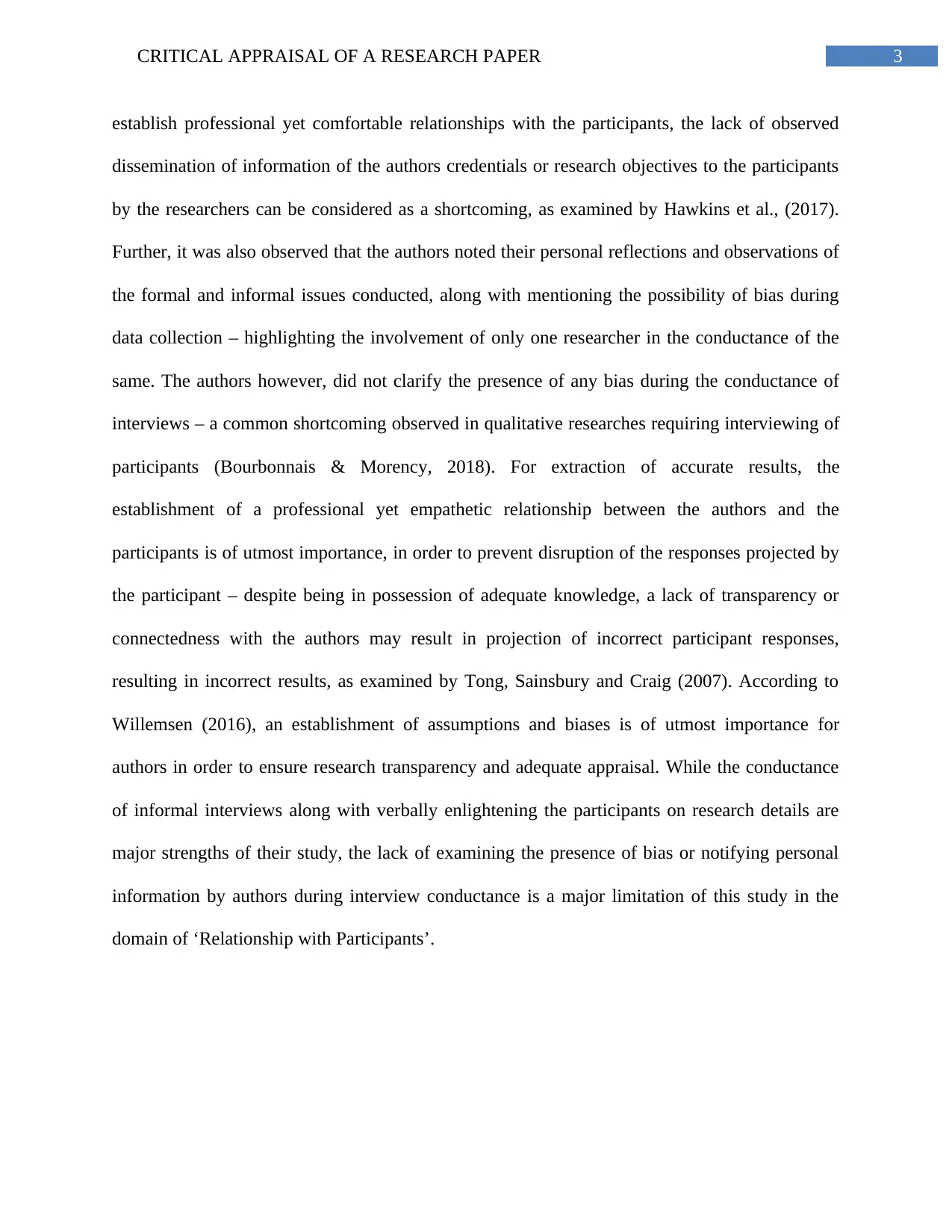
3CRITICAL APPRAISAL OF A RESEARCH PAPER
establish professional yet comfortable relationships with the participants, the lack of observed
dissemination of information of the authors credentials or research objectives to the participants
by the researchers can be considered as a shortcoming, as examined by Hawkins et al., (2017).
Further, it was also observed that the authors noted their personal reflections and observations of
the formal and informal issues conducted, along with mentioning the possibility of bias during
data collection – highlighting the involvement of only one researcher in the conductance of the
same. The authors however, did not clarify the presence of any bias during the conductance of
interviews – a common shortcoming observed in qualitative researches requiring interviewing of
participants (Bourbonnais & Morency, 2018). For extraction of accurate results, the
establishment of a professional yet empathetic relationship between the authors and the
participants is of utmost importance, in order to prevent disruption of the responses projected by
the participant – despite being in possession of adequate knowledge, a lack of transparency or
connectedness with the authors may result in projection of incorrect participant responses,
resulting in incorrect results, as examined by Tong, Sainsbury and Craig (2007). According to
Willemsen (2016), an establishment of assumptions and biases is of utmost importance for
authors in order to ensure research transparency and adequate appraisal. While the conductance
of informal interviews along with verbally enlightening the participants on research details are
major strengths of their study, the lack of examining the presence of bias or notifying personal
information by authors during interview conductance is a major limitation of this study in the
domain of ‘Relationship with Participants’.
establish professional yet comfortable relationships with the participants, the lack of observed
dissemination of information of the authors credentials or research objectives to the participants
by the researchers can be considered as a shortcoming, as examined by Hawkins et al., (2017).
Further, it was also observed that the authors noted their personal reflections and observations of
the formal and informal issues conducted, along with mentioning the possibility of bias during
data collection – highlighting the involvement of only one researcher in the conductance of the
same. The authors however, did not clarify the presence of any bias during the conductance of
interviews – a common shortcoming observed in qualitative researches requiring interviewing of
participants (Bourbonnais & Morency, 2018). For extraction of accurate results, the
establishment of a professional yet empathetic relationship between the authors and the
participants is of utmost importance, in order to prevent disruption of the responses projected by
the participant – despite being in possession of adequate knowledge, a lack of transparency or
connectedness with the authors may result in projection of incorrect participant responses,
resulting in incorrect results, as examined by Tong, Sainsbury and Craig (2007). According to
Willemsen (2016), an establishment of assumptions and biases is of utmost importance for
authors in order to ensure research transparency and adequate appraisal. While the conductance
of informal interviews along with verbally enlightening the participants on research details are
major strengths of their study, the lack of examining the presence of bias or notifying personal
information by authors during interview conductance is a major limitation of this study in the
domain of ‘Relationship with Participants’.
Secure Best Marks with AI Grader
Need help grading? Try our AI Grader for instant feedback on your assignments.
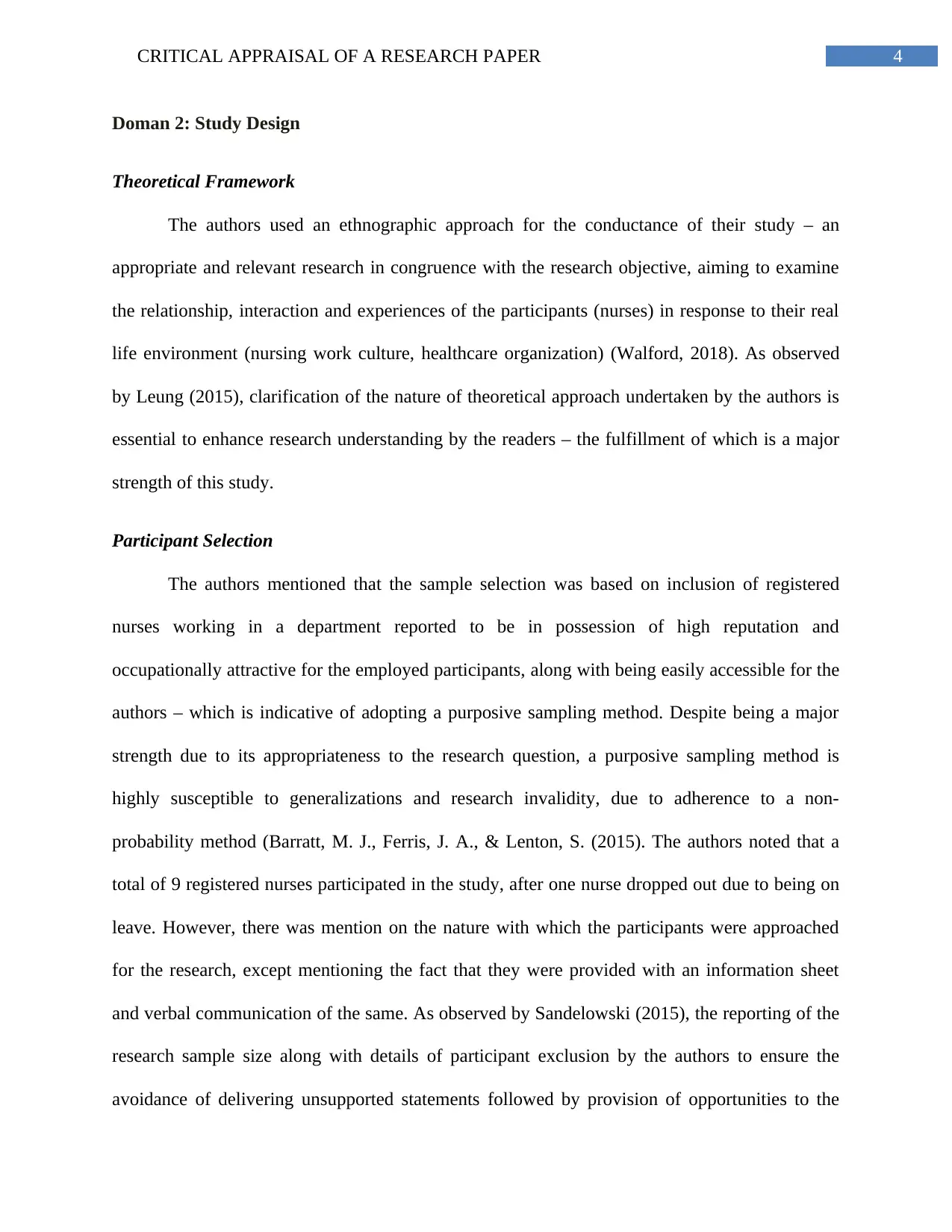
4CRITICAL APPRAISAL OF A RESEARCH PAPER
Doman 2: Study Design
Theoretical Framework
The authors used an ethnographic approach for the conductance of their study – an
appropriate and relevant research in congruence with the research objective, aiming to examine
the relationship, interaction and experiences of the participants (nurses) in response to their real
life environment (nursing work culture, healthcare organization) (Walford, 2018). As observed
by Leung (2015), clarification of the nature of theoretical approach undertaken by the authors is
essential to enhance research understanding by the readers – the fulfillment of which is a major
strength of this study.
Participant Selection
The authors mentioned that the sample selection was based on inclusion of registered
nurses working in a department reported to be in possession of high reputation and
occupationally attractive for the employed participants, along with being easily accessible for the
authors – which is indicative of adopting a purposive sampling method. Despite being a major
strength due to its appropriateness to the research question, a purposive sampling method is
highly susceptible to generalizations and research invalidity, due to adherence to a non-
probability method (Barratt, M. J., Ferris, J. A., & Lenton, S. (2015). The authors noted that a
total of 9 registered nurses participated in the study, after one nurse dropped out due to being on
leave. However, there was mention on the nature with which the participants were approached
for the research, except mentioning the fact that they were provided with an information sheet
and verbal communication of the same. As observed by Sandelowski (2015), the reporting of the
research sample size along with details of participant exclusion by the authors to ensure the
avoidance of delivering unsupported statements followed by provision of opportunities to the
Doman 2: Study Design
Theoretical Framework
The authors used an ethnographic approach for the conductance of their study – an
appropriate and relevant research in congruence with the research objective, aiming to examine
the relationship, interaction and experiences of the participants (nurses) in response to their real
life environment (nursing work culture, healthcare organization) (Walford, 2018). As observed
by Leung (2015), clarification of the nature of theoretical approach undertaken by the authors is
essential to enhance research understanding by the readers – the fulfillment of which is a major
strength of this study.
Participant Selection
The authors mentioned that the sample selection was based on inclusion of registered
nurses working in a department reported to be in possession of high reputation and
occupationally attractive for the employed participants, along with being easily accessible for the
authors – which is indicative of adopting a purposive sampling method. Despite being a major
strength due to its appropriateness to the research question, a purposive sampling method is
highly susceptible to generalizations and research invalidity, due to adherence to a non-
probability method (Barratt, M. J., Ferris, J. A., & Lenton, S. (2015). The authors noted that a
total of 9 registered nurses participated in the study, after one nurse dropped out due to being on
leave. However, there was mention on the nature with which the participants were approached
for the research, except mentioning the fact that they were provided with an information sheet
and verbal communication of the same. As observed by Sandelowski (2015), the reporting of the
research sample size along with details of participant exclusion by the authors to ensure the
avoidance of delivering unsupported statements followed by provision of opportunities to the
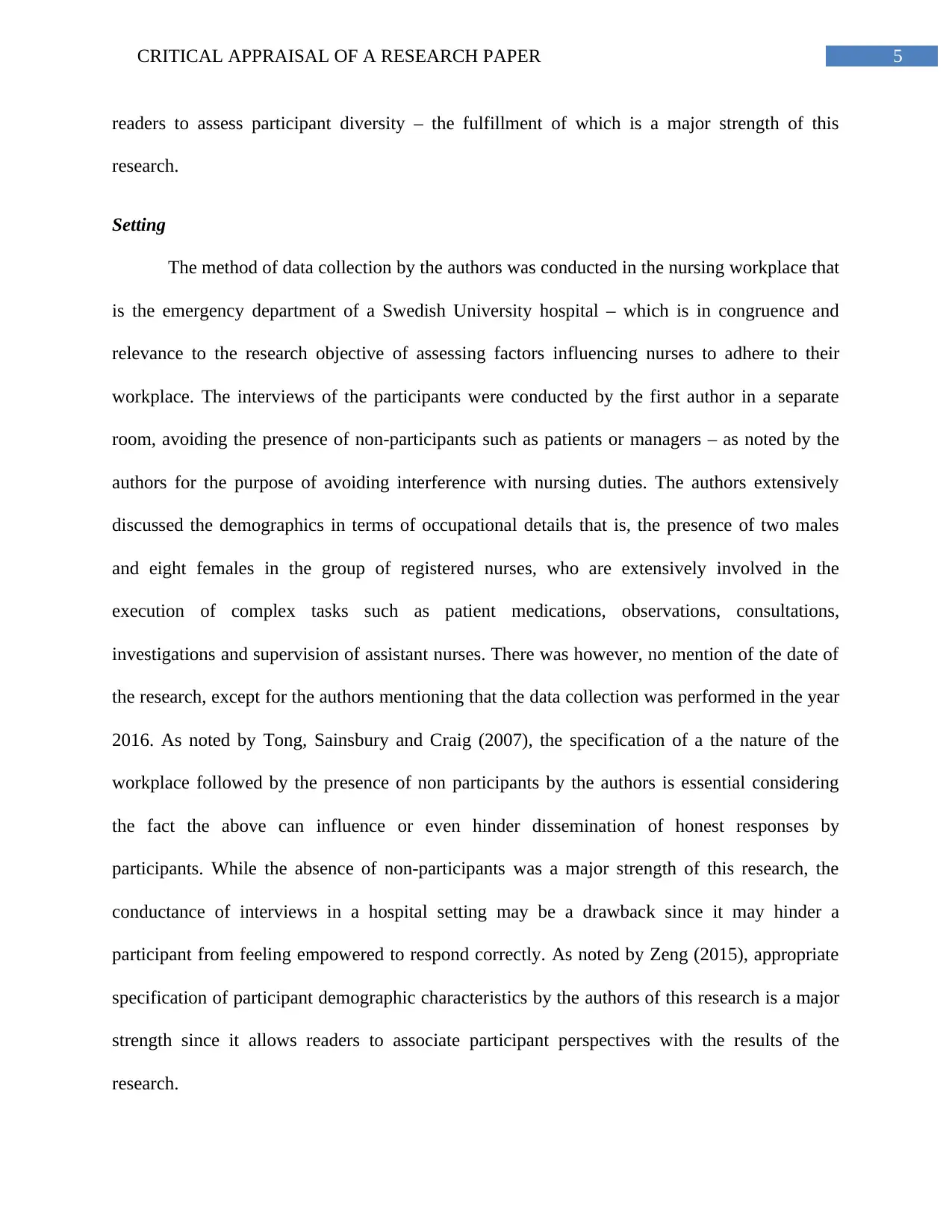
5CRITICAL APPRAISAL OF A RESEARCH PAPER
readers to assess participant diversity – the fulfillment of which is a major strength of this
research.
Setting
The method of data collection by the authors was conducted in the nursing workplace that
is the emergency department of a Swedish University hospital – which is in congruence and
relevance to the research objective of assessing factors influencing nurses to adhere to their
workplace. The interviews of the participants were conducted by the first author in a separate
room, avoiding the presence of non-participants such as patients or managers – as noted by the
authors for the purpose of avoiding interference with nursing duties. The authors extensively
discussed the demographics in terms of occupational details that is, the presence of two males
and eight females in the group of registered nurses, who are extensively involved in the
execution of complex tasks such as patient medications, observations, consultations,
investigations and supervision of assistant nurses. There was however, no mention of the date of
the research, except for the authors mentioning that the data collection was performed in the year
2016. As noted by Tong, Sainsbury and Craig (2007), the specification of a the nature of the
workplace followed by the presence of non participants by the authors is essential considering
the fact the above can influence or even hinder dissemination of honest responses by
participants. While the absence of non-participants was a major strength of this research, the
conductance of interviews in a hospital setting may be a drawback since it may hinder a
participant from feeling empowered to respond correctly. As noted by Zeng (2015), appropriate
specification of participant demographic characteristics by the authors of this research is a major
strength since it allows readers to associate participant perspectives with the results of the
research.
readers to assess participant diversity – the fulfillment of which is a major strength of this
research.
Setting
The method of data collection by the authors was conducted in the nursing workplace that
is the emergency department of a Swedish University hospital – which is in congruence and
relevance to the research objective of assessing factors influencing nurses to adhere to their
workplace. The interviews of the participants were conducted by the first author in a separate
room, avoiding the presence of non-participants such as patients or managers – as noted by the
authors for the purpose of avoiding interference with nursing duties. The authors extensively
discussed the demographics in terms of occupational details that is, the presence of two males
and eight females in the group of registered nurses, who are extensively involved in the
execution of complex tasks such as patient medications, observations, consultations,
investigations and supervision of assistant nurses. There was however, no mention of the date of
the research, except for the authors mentioning that the data collection was performed in the year
2016. As noted by Tong, Sainsbury and Craig (2007), the specification of a the nature of the
workplace followed by the presence of non participants by the authors is essential considering
the fact the above can influence or even hinder dissemination of honest responses by
participants. While the absence of non-participants was a major strength of this research, the
conductance of interviews in a hospital setting may be a drawback since it may hinder a
participant from feeling empowered to respond correctly. As noted by Zeng (2015), appropriate
specification of participant demographic characteristics by the authors of this research is a major
strength since it allows readers to associate participant perspectives with the results of the
research.
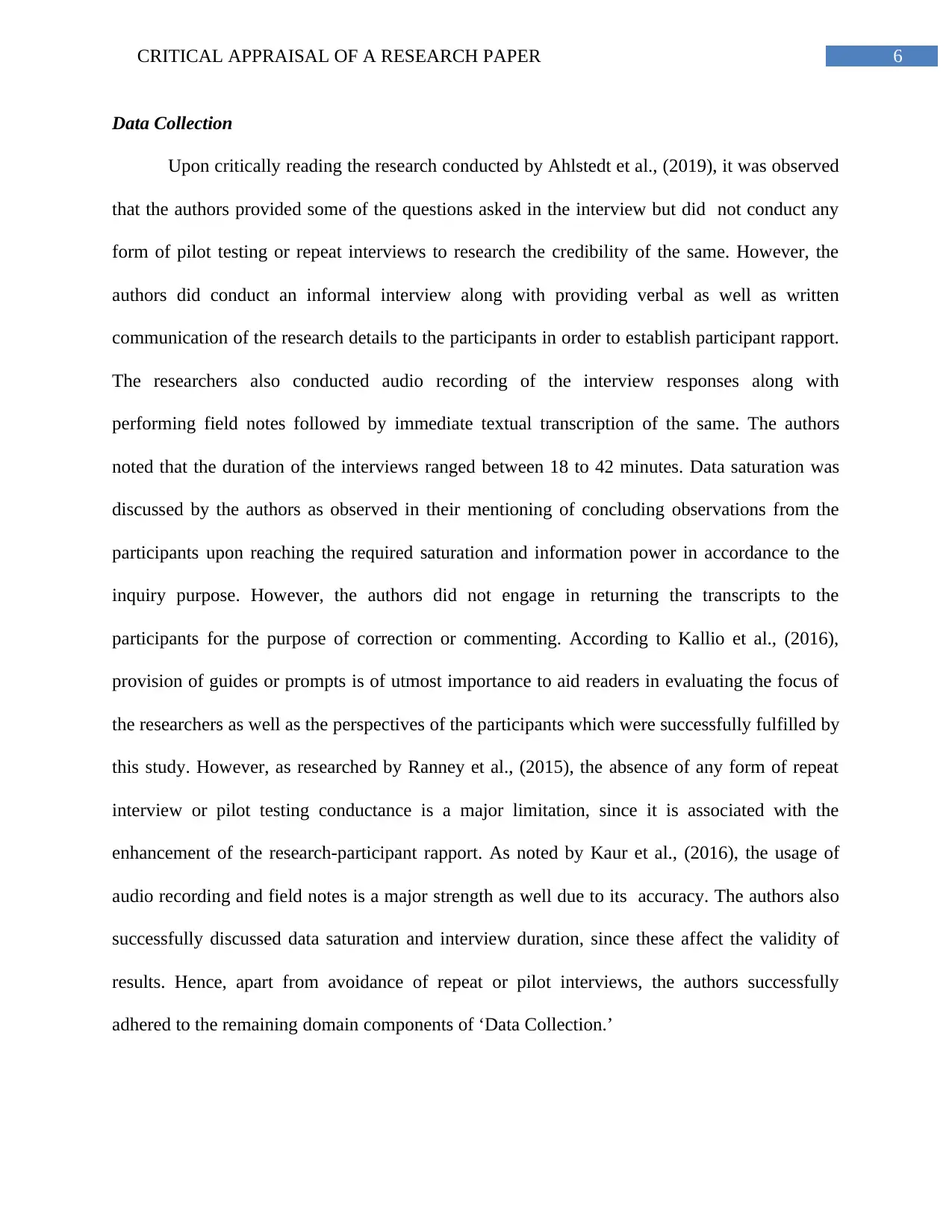
6CRITICAL APPRAISAL OF A RESEARCH PAPER
Data Collection
Upon critically reading the research conducted by Ahlstedt et al., (2019), it was observed
that the authors provided some of the questions asked in the interview but did not conduct any
form of pilot testing or repeat interviews to research the credibility of the same. However, the
authors did conduct an informal interview along with providing verbal as well as written
communication of the research details to the participants in order to establish participant rapport.
The researchers also conducted audio recording of the interview responses along with
performing field notes followed by immediate textual transcription of the same. The authors
noted that the duration of the interviews ranged between 18 to 42 minutes. Data saturation was
discussed by the authors as observed in their mentioning of concluding observations from the
participants upon reaching the required saturation and information power in accordance to the
inquiry purpose. However, the authors did not engage in returning the transcripts to the
participants for the purpose of correction or commenting. According to Kallio et al., (2016),
provision of guides or prompts is of utmost importance to aid readers in evaluating the focus of
the researchers as well as the perspectives of the participants which were successfully fulfilled by
this study. However, as researched by Ranney et al., (2015), the absence of any form of repeat
interview or pilot testing conductance is a major limitation, since it is associated with the
enhancement of the research-participant rapport. As noted by Kaur et al., (2016), the usage of
audio recording and field notes is a major strength as well due to its accuracy. The authors also
successfully discussed data saturation and interview duration, since these affect the validity of
results. Hence, apart from avoidance of repeat or pilot interviews, the authors successfully
adhered to the remaining domain components of ‘Data Collection.’
Data Collection
Upon critically reading the research conducted by Ahlstedt et al., (2019), it was observed
that the authors provided some of the questions asked in the interview but did not conduct any
form of pilot testing or repeat interviews to research the credibility of the same. However, the
authors did conduct an informal interview along with providing verbal as well as written
communication of the research details to the participants in order to establish participant rapport.
The researchers also conducted audio recording of the interview responses along with
performing field notes followed by immediate textual transcription of the same. The authors
noted that the duration of the interviews ranged between 18 to 42 minutes. Data saturation was
discussed by the authors as observed in their mentioning of concluding observations from the
participants upon reaching the required saturation and information power in accordance to the
inquiry purpose. However, the authors did not engage in returning the transcripts to the
participants for the purpose of correction or commenting. According to Kallio et al., (2016),
provision of guides or prompts is of utmost importance to aid readers in evaluating the focus of
the researchers as well as the perspectives of the participants which were successfully fulfilled by
this study. However, as researched by Ranney et al., (2015), the absence of any form of repeat
interview or pilot testing conductance is a major limitation, since it is associated with the
enhancement of the research-participant rapport. As noted by Kaur et al., (2016), the usage of
audio recording and field notes is a major strength as well due to its accuracy. The authors also
successfully discussed data saturation and interview duration, since these affect the validity of
results. Hence, apart from avoidance of repeat or pilot interviews, the authors successfully
adhered to the remaining domain components of ‘Data Collection.’
Paraphrase This Document
Need a fresh take? Get an instant paraphrase of this document with our AI Paraphraser
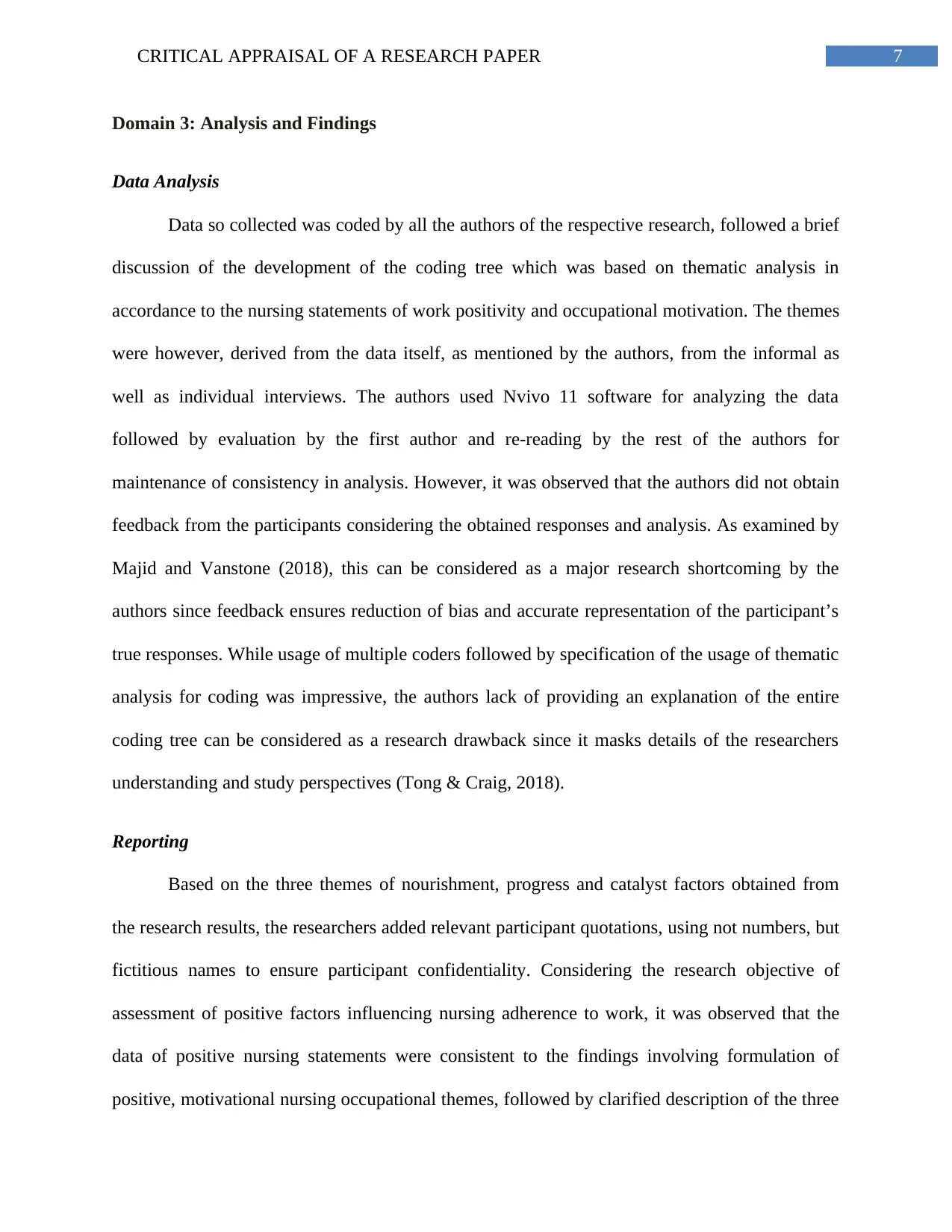
7CRITICAL APPRAISAL OF A RESEARCH PAPER
Domain 3: Analysis and Findings
Data Analysis
Data so collected was coded by all the authors of the respective research, followed a brief
discussion of the development of the coding tree which was based on thematic analysis in
accordance to the nursing statements of work positivity and occupational motivation. The themes
were however, derived from the data itself, as mentioned by the authors, from the informal as
well as individual interviews. The authors used Nvivo 11 software for analyzing the data
followed by evaluation by the first author and re-reading by the rest of the authors for
maintenance of consistency in analysis. However, it was observed that the authors did not obtain
feedback from the participants considering the obtained responses and analysis. As examined by
Majid and Vanstone (2018), this can be considered as a major research shortcoming by the
authors since feedback ensures reduction of bias and accurate representation of the participant’s
true responses. While usage of multiple coders followed by specification of the usage of thematic
analysis for coding was impressive, the authors lack of providing an explanation of the entire
coding tree can be considered as a research drawback since it masks details of the researchers
understanding and study perspectives (Tong & Craig, 2018).
Reporting
Based on the three themes of nourishment, progress and catalyst factors obtained from
the research results, the researchers added relevant participant quotations, using not numbers, but
fictitious names to ensure participant confidentiality. Considering the research objective of
assessment of positive factors influencing nursing adherence to work, it was observed that the
data of positive nursing statements were consistent to the findings involving formulation of
positive, motivational nursing occupational themes, followed by clarified description of the three
Domain 3: Analysis and Findings
Data Analysis
Data so collected was coded by all the authors of the respective research, followed a brief
discussion of the development of the coding tree which was based on thematic analysis in
accordance to the nursing statements of work positivity and occupational motivation. The themes
were however, derived from the data itself, as mentioned by the authors, from the informal as
well as individual interviews. The authors used Nvivo 11 software for analyzing the data
followed by evaluation by the first author and re-reading by the rest of the authors for
maintenance of consistency in analysis. However, it was observed that the authors did not obtain
feedback from the participants considering the obtained responses and analysis. As examined by
Majid and Vanstone (2018), this can be considered as a major research shortcoming by the
authors since feedback ensures reduction of bias and accurate representation of the participant’s
true responses. While usage of multiple coders followed by specification of the usage of thematic
analysis for coding was impressive, the authors lack of providing an explanation of the entire
coding tree can be considered as a research drawback since it masks details of the researchers
understanding and study perspectives (Tong & Craig, 2018).
Reporting
Based on the three themes of nourishment, progress and catalyst factors obtained from
the research results, the researchers added relevant participant quotations, using not numbers, but
fictitious names to ensure participant confidentiality. Considering the research objective of
assessment of positive factors influencing nursing adherence to work, it was observed that the
data of positive nursing statements were consistent to the findings involving formulation of
positive, motivational nursing occupational themes, followed by clarified description of the three
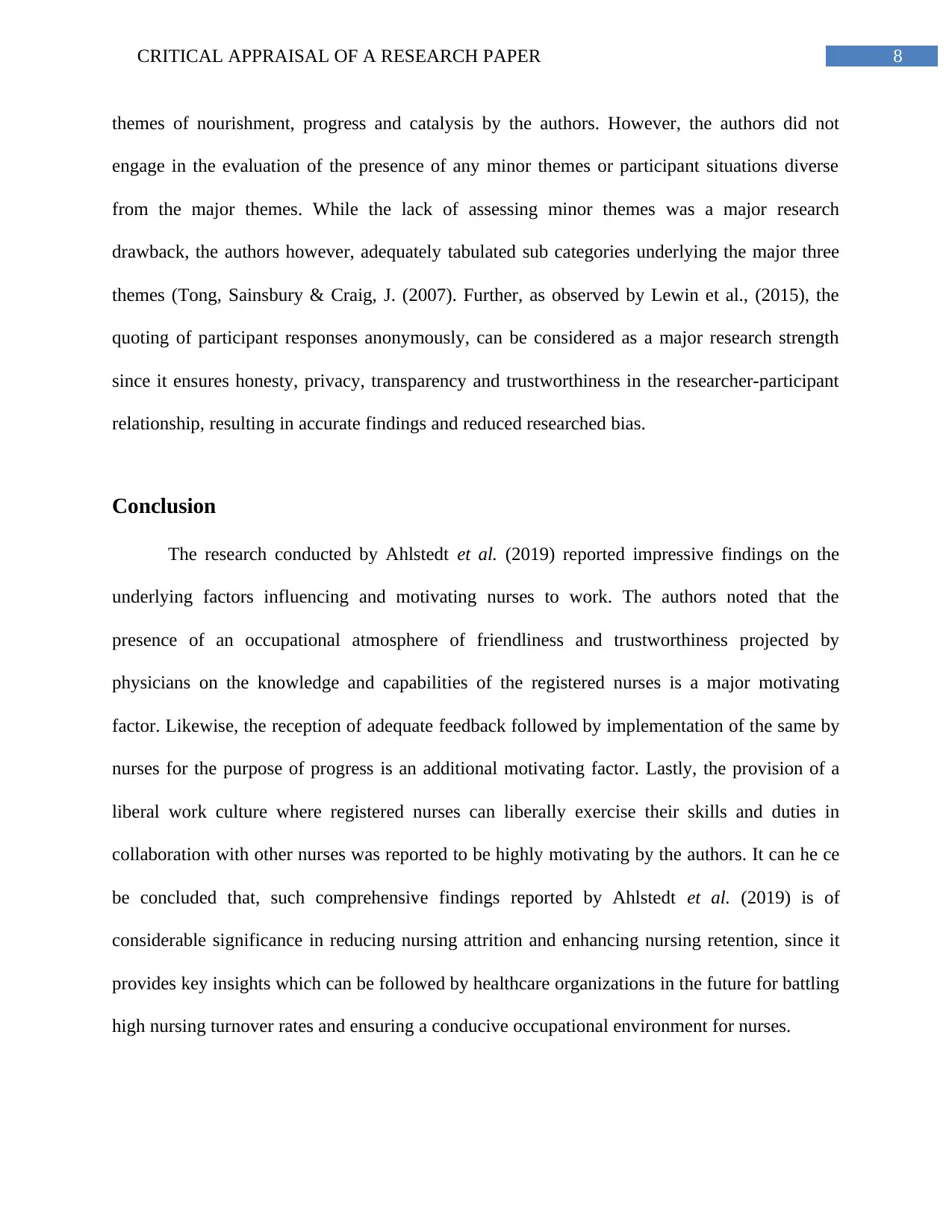
8CRITICAL APPRAISAL OF A RESEARCH PAPER
themes of nourishment, progress and catalysis by the authors. However, the authors did not
engage in the evaluation of the presence of any minor themes or participant situations diverse
from the major themes. While the lack of assessing minor themes was a major research
drawback, the authors however, adequately tabulated sub categories underlying the major three
themes (Tong, Sainsbury & Craig, J. (2007). Further, as observed by Lewin et al., (2015), the
quoting of participant responses anonymously, can be considered as a major research strength
since it ensures honesty, privacy, transparency and trustworthiness in the researcher-participant
relationship, resulting in accurate findings and reduced researched bias.
Conclusion
The research conducted by Ahlstedt et al. (2019) reported impressive findings on the
underlying factors influencing and motivating nurses to work. The authors noted that the
presence of an occupational atmosphere of friendliness and trustworthiness projected by
physicians on the knowledge and capabilities of the registered nurses is a major motivating
factor. Likewise, the reception of adequate feedback followed by implementation of the same by
nurses for the purpose of progress is an additional motivating factor. Lastly, the provision of a
liberal work culture where registered nurses can liberally exercise their skills and duties in
collaboration with other nurses was reported to be highly motivating by the authors. It can he ce
be concluded that, such comprehensive findings reported by Ahlstedt et al. (2019) is of
considerable significance in reducing nursing attrition and enhancing nursing retention, since it
provides key insights which can be followed by healthcare organizations in the future for battling
high nursing turnover rates and ensuring a conducive occupational environment for nurses.
themes of nourishment, progress and catalysis by the authors. However, the authors did not
engage in the evaluation of the presence of any minor themes or participant situations diverse
from the major themes. While the lack of assessing minor themes was a major research
drawback, the authors however, adequately tabulated sub categories underlying the major three
themes (Tong, Sainsbury & Craig, J. (2007). Further, as observed by Lewin et al., (2015), the
quoting of participant responses anonymously, can be considered as a major research strength
since it ensures honesty, privacy, transparency and trustworthiness in the researcher-participant
relationship, resulting in accurate findings and reduced researched bias.
Conclusion
The research conducted by Ahlstedt et al. (2019) reported impressive findings on the
underlying factors influencing and motivating nurses to work. The authors noted that the
presence of an occupational atmosphere of friendliness and trustworthiness projected by
physicians on the knowledge and capabilities of the registered nurses is a major motivating
factor. Likewise, the reception of adequate feedback followed by implementation of the same by
nurses for the purpose of progress is an additional motivating factor. Lastly, the provision of a
liberal work culture where registered nurses can liberally exercise their skills and duties in
collaboration with other nurses was reported to be highly motivating by the authors. It can he ce
be concluded that, such comprehensive findings reported by Ahlstedt et al. (2019) is of
considerable significance in reducing nursing attrition and enhancing nursing retention, since it
provides key insights which can be followed by healthcare organizations in the future for battling
high nursing turnover rates and ensuring a conducive occupational environment for nurses.
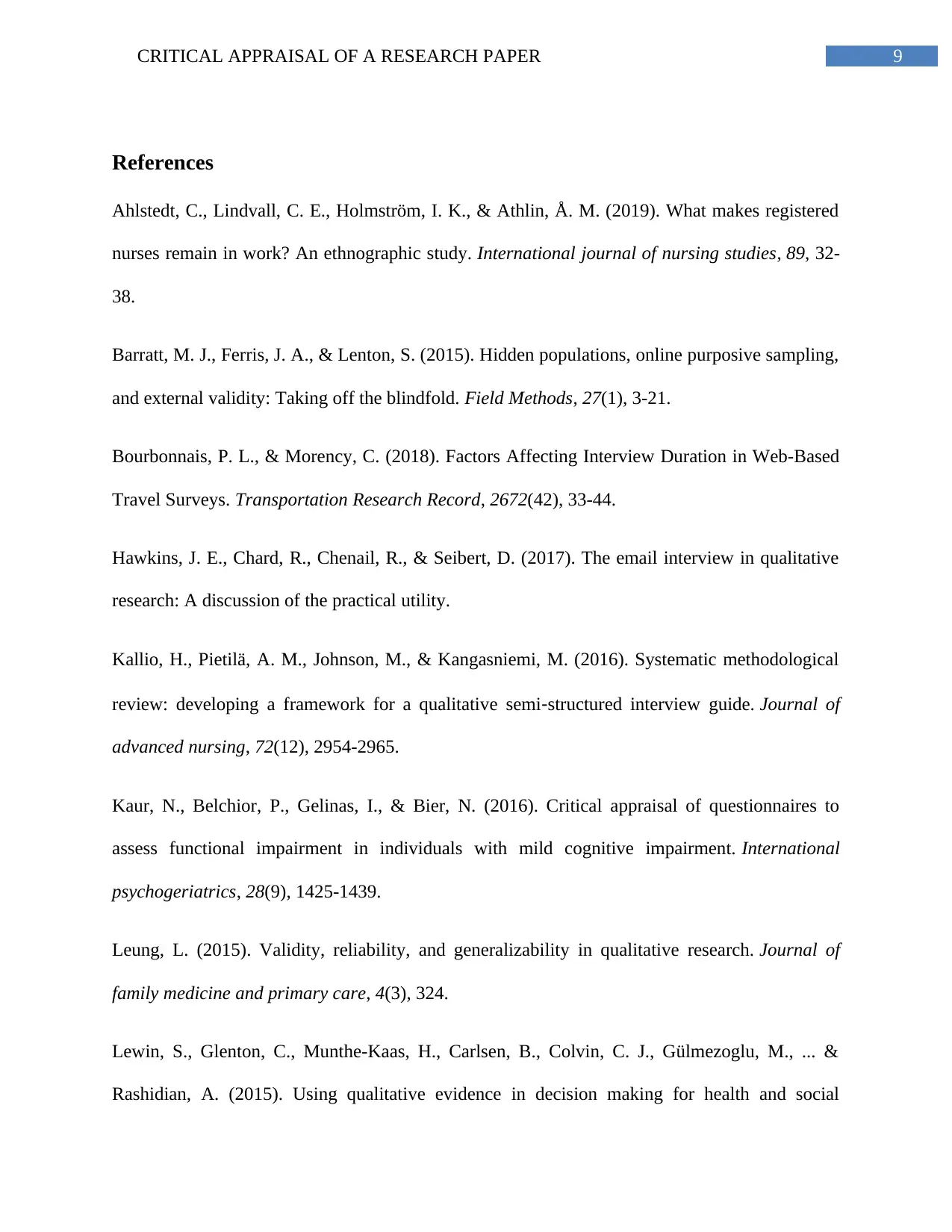
9CRITICAL APPRAISAL OF A RESEARCH PAPER
References
Ahlstedt, C., Lindvall, C. E., Holmström, I. K., & Athlin, Å. M. (2019). What makes registered
nurses remain in work? An ethnographic study. International journal of nursing studies, 89, 32-
38.
Barratt, M. J., Ferris, J. A., & Lenton, S. (2015). Hidden populations, online purposive sampling,
and external validity: Taking off the blindfold. Field Methods, 27(1), 3-21.
Bourbonnais, P. L., & Morency, C. (2018). Factors Affecting Interview Duration in Web-Based
Travel Surveys. Transportation Research Record, 2672(42), 33-44.
Hawkins, J. E., Chard, R., Chenail, R., & Seibert, D. (2017). The email interview in qualitative
research: A discussion of the practical utility.
Kallio, H., Pietilä, A. M., Johnson, M., & Kangasniemi, M. (2016). Systematic methodological
review: developing a framework for a qualitative semi‐structured interview guide. Journal of
advanced nursing, 72(12), 2954-2965.
Kaur, N., Belchior, P., Gelinas, I., & Bier, N. (2016). Critical appraisal of questionnaires to
assess functional impairment in individuals with mild cognitive impairment. International
psychogeriatrics, 28(9), 1425-1439.
Leung, L. (2015). Validity, reliability, and generalizability in qualitative research. Journal of
family medicine and primary care, 4(3), 324.
Lewin, S., Glenton, C., Munthe-Kaas, H., Carlsen, B., Colvin, C. J., Gülmezoglu, M., ... &
Rashidian, A. (2015). Using qualitative evidence in decision making for health and social
References
Ahlstedt, C., Lindvall, C. E., Holmström, I. K., & Athlin, Å. M. (2019). What makes registered
nurses remain in work? An ethnographic study. International journal of nursing studies, 89, 32-
38.
Barratt, M. J., Ferris, J. A., & Lenton, S. (2015). Hidden populations, online purposive sampling,
and external validity: Taking off the blindfold. Field Methods, 27(1), 3-21.
Bourbonnais, P. L., & Morency, C. (2018). Factors Affecting Interview Duration in Web-Based
Travel Surveys. Transportation Research Record, 2672(42), 33-44.
Hawkins, J. E., Chard, R., Chenail, R., & Seibert, D. (2017). The email interview in qualitative
research: A discussion of the practical utility.
Kallio, H., Pietilä, A. M., Johnson, M., & Kangasniemi, M. (2016). Systematic methodological
review: developing a framework for a qualitative semi‐structured interview guide. Journal of
advanced nursing, 72(12), 2954-2965.
Kaur, N., Belchior, P., Gelinas, I., & Bier, N. (2016). Critical appraisal of questionnaires to
assess functional impairment in individuals with mild cognitive impairment. International
psychogeriatrics, 28(9), 1425-1439.
Leung, L. (2015). Validity, reliability, and generalizability in qualitative research. Journal of
family medicine and primary care, 4(3), 324.
Lewin, S., Glenton, C., Munthe-Kaas, H., Carlsen, B., Colvin, C. J., Gülmezoglu, M., ... &
Rashidian, A. (2015). Using qualitative evidence in decision making for health and social
Secure Best Marks with AI Grader
Need help grading? Try our AI Grader for instant feedback on your assignments.
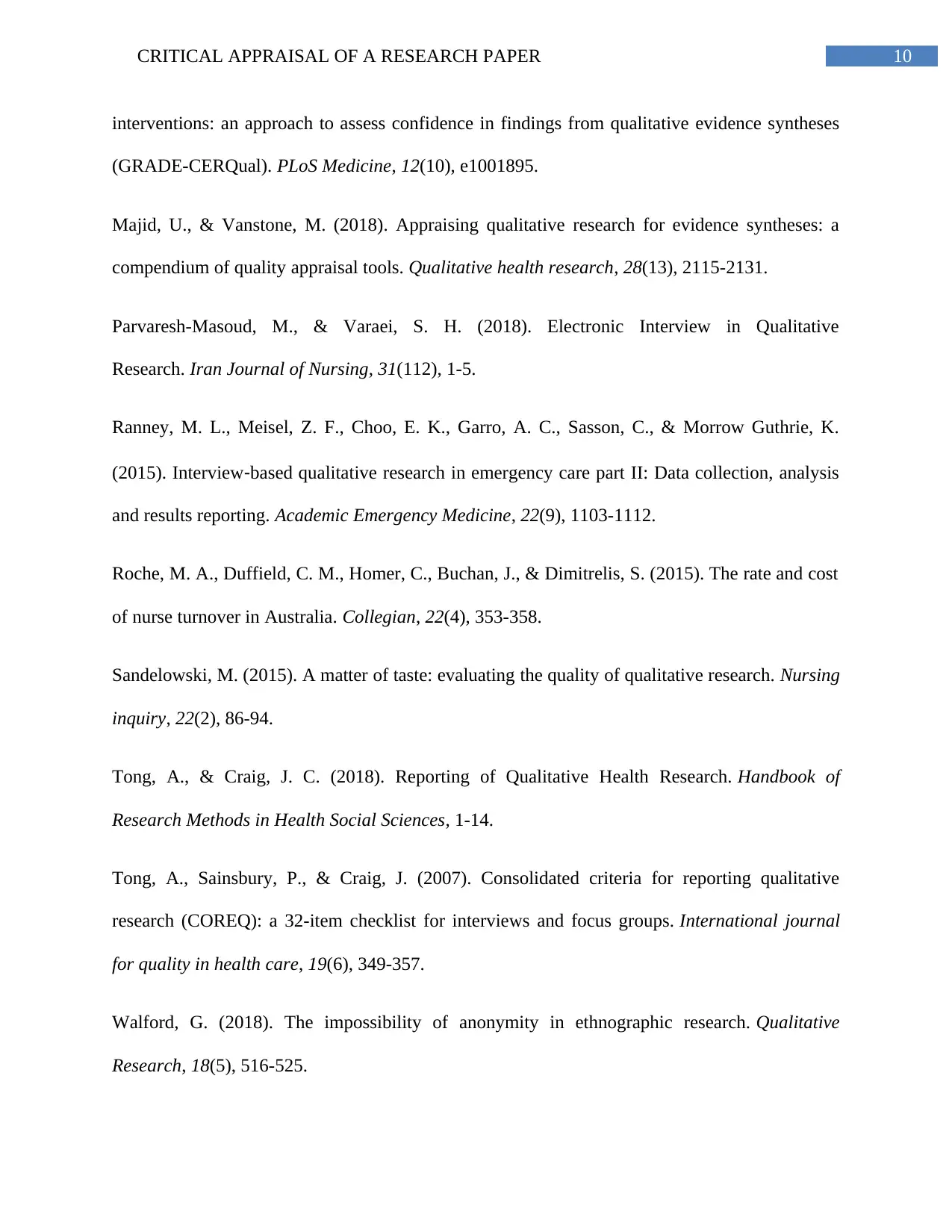
10CRITICAL APPRAISAL OF A RESEARCH PAPER
interventions: an approach to assess confidence in findings from qualitative evidence syntheses
(GRADE-CERQual). PLoS Medicine, 12(10), e1001895.
Majid, U., & Vanstone, M. (2018). Appraising qualitative research for evidence syntheses: a
compendium of quality appraisal tools. Qualitative health research, 28(13), 2115-2131.
Parvaresh-Masoud, M., & Varaei, S. H. (2018). Electronic Interview in Qualitative
Research. Iran Journal of Nursing, 31(112), 1-5.
Ranney, M. L., Meisel, Z. F., Choo, E. K., Garro, A. C., Sasson, C., & Morrow Guthrie, K.
(2015). Interview‐based qualitative research in emergency care part II: Data collection, analysis
and results reporting. Academic Emergency Medicine, 22(9), 1103-1112.
Roche, M. A., Duffield, C. M., Homer, C., Buchan, J., & Dimitrelis, S. (2015). The rate and cost
of nurse turnover in Australia. Collegian, 22(4), 353-358.
Sandelowski, M. (2015). A matter of taste: evaluating the quality of qualitative research. Nursing
inquiry, 22(2), 86-94.
Tong, A., & Craig, J. C. (2018). Reporting of Qualitative Health Research. Handbook of
Research Methods in Health Social Sciences, 1-14.
Tong, A., Sainsbury, P., & Craig, J. (2007). Consolidated criteria for reporting qualitative
research (COREQ): a 32-item checklist for interviews and focus groups. International journal
for quality in health care, 19(6), 349-357.
Walford, G. (2018). The impossibility of anonymity in ethnographic research. Qualitative
Research, 18(5), 516-525.
interventions: an approach to assess confidence in findings from qualitative evidence syntheses
(GRADE-CERQual). PLoS Medicine, 12(10), e1001895.
Majid, U., & Vanstone, M. (2018). Appraising qualitative research for evidence syntheses: a
compendium of quality appraisal tools. Qualitative health research, 28(13), 2115-2131.
Parvaresh-Masoud, M., & Varaei, S. H. (2018). Electronic Interview in Qualitative
Research. Iran Journal of Nursing, 31(112), 1-5.
Ranney, M. L., Meisel, Z. F., Choo, E. K., Garro, A. C., Sasson, C., & Morrow Guthrie, K.
(2015). Interview‐based qualitative research in emergency care part II: Data collection, analysis
and results reporting. Academic Emergency Medicine, 22(9), 1103-1112.
Roche, M. A., Duffield, C. M., Homer, C., Buchan, J., & Dimitrelis, S. (2015). The rate and cost
of nurse turnover in Australia. Collegian, 22(4), 353-358.
Sandelowski, M. (2015). A matter of taste: evaluating the quality of qualitative research. Nursing
inquiry, 22(2), 86-94.
Tong, A., & Craig, J. C. (2018). Reporting of Qualitative Health Research. Handbook of
Research Methods in Health Social Sciences, 1-14.
Tong, A., Sainsbury, P., & Craig, J. (2007). Consolidated criteria for reporting qualitative
research (COREQ): a 32-item checklist for interviews and focus groups. International journal
for quality in health care, 19(6), 349-357.
Walford, G. (2018). The impossibility of anonymity in ethnographic research. Qualitative
Research, 18(5), 516-525.
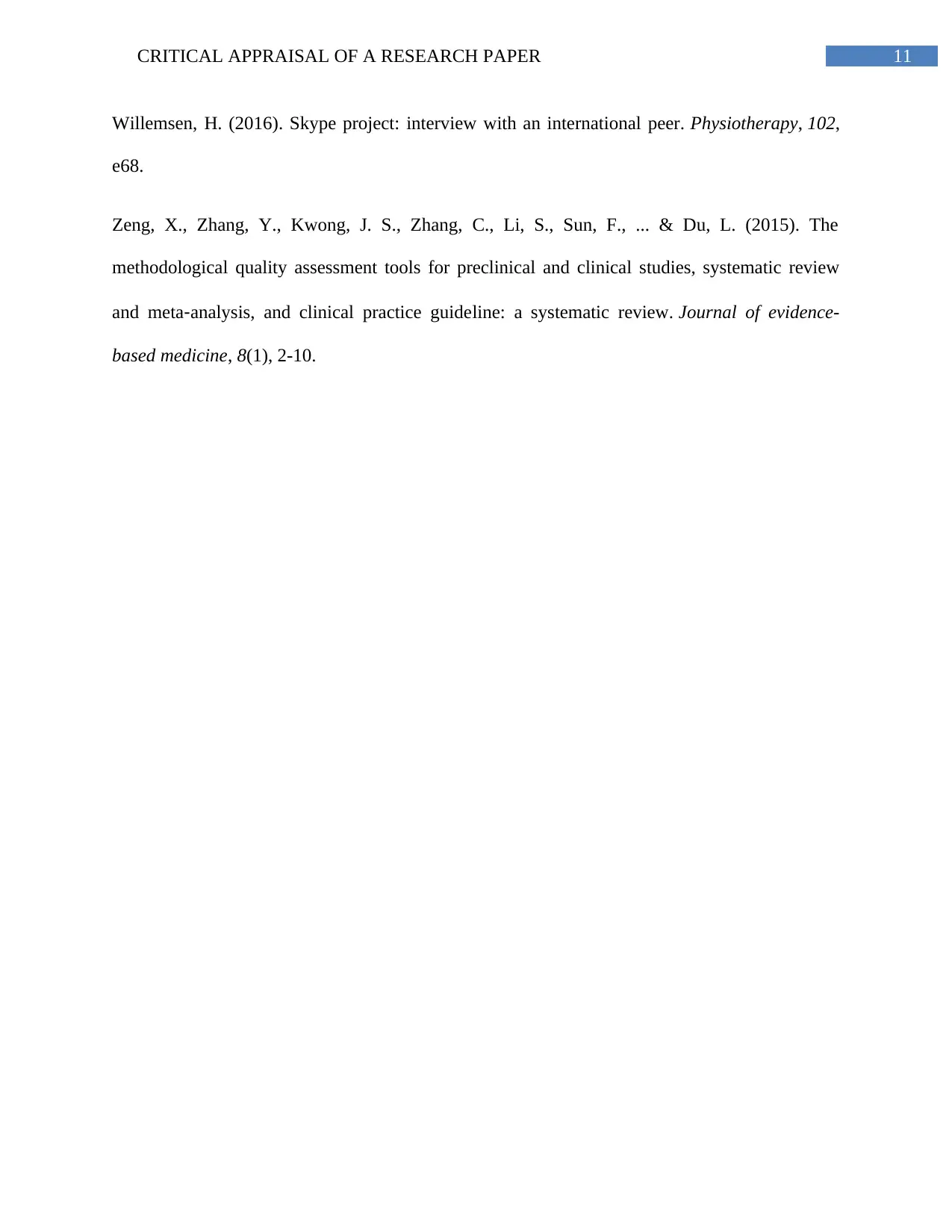
11CRITICAL APPRAISAL OF A RESEARCH PAPER
Willemsen, H. (2016). Skype project: interview with an international peer. Physiotherapy, 102,
e68.
Zeng, X., Zhang, Y., Kwong, J. S., Zhang, C., Li, S., Sun, F., ... & Du, L. (2015). The
methodological quality assessment tools for preclinical and clinical studies, systematic review
and meta‐analysis, and clinical practice guideline: a systematic review. Journal of evidence-
based medicine, 8(1), 2-10.
Willemsen, H. (2016). Skype project: interview with an international peer. Physiotherapy, 102,
e68.
Zeng, X., Zhang, Y., Kwong, J. S., Zhang, C., Li, S., Sun, F., ... & Du, L. (2015). The
methodological quality assessment tools for preclinical and clinical studies, systematic review
and meta‐analysis, and clinical practice guideline: a systematic review. Journal of evidence-
based medicine, 8(1), 2-10.
1 out of 12
Related Documents
Your All-in-One AI-Powered Toolkit for Academic Success.
+13062052269
info@desklib.com
Available 24*7 on WhatsApp / Email
![[object Object]](/_next/static/media/star-bottom.7253800d.svg)
Unlock your academic potential
© 2024 | Zucol Services PVT LTD | All rights reserved.





